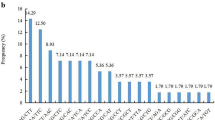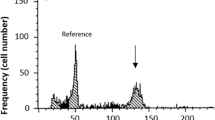Abstract
Simple sequence repeat oligonucleotides were used to probe the tomato genome for elements displaying variability amongst commercial cultivars. The oligonucleotide (GACA)4 was found to be particularly informative on genotype screening blots, hybridising to a highly polymorphic family of elements, and was used to clone one such member from a lambda library. The GACA-hybridisation was localised to a 1.3-kbHinfI fragment within the original 15-kb lambda insert. This 1,349-bp subclone (pT-GACA-2:1.3) was used to probe 27 Californian processing varieties and found to be capable of distinguishing all from each other, thus demonstrating its utility as a genetic fingerprinting probe for cultivar identification. Hybridisation occurred to approximately 10 major high molecular weight (> 4-kb) bands, most of which segregated independently in F2 populations, as well as a large number of less clearly resolvable smaller fragments. Sequence analysis of the cloned element reveals that it is almost entirely composed of GACA or GATA repeats. These tetranucleotides are organised into distinct repetitive domains, consisting either of tandem arrays of each tetranucleotide or interspersions of GACA and GATA to form dodecanucleotides that are then further repeated. The boundaries between domains contain sufficient departures from the concensus repeat to allow construction of unique polymerase chain reaction (PCR) primers. Amplification from two such contiguous regions identifies length variation in both, thus yielding a genotype screen appropriate for high-throughput applications, such as assessment of purity in F1 hybrid seed lots.
Similar content being viewed by others
References
Akkaya MS, Bhagwat AA, Cregan PB (1992) Length polymorphisms of simple sequence repeat DNA in soybean. Genetics 132: 1131–1139
Beyermann B, Nürnberg P, Weihe A, Meixner M, Epplen JT, Börner T (1992) Fingerprinting plant genomes with oligonucleotide probes specific for simple repetitive DNA sequences. Theor Appl Genet 83:691–694
Broun P, Ganal MW, Tanksley SD (1992) Telomeric arrays display high levels of heritable polymorphism among closely related plant varieties. Proc Natl Acad Sci USA 89:1354–1357
Chao S, Sharp PJ, Worland AJ, Warham EJ, Koebner RMD, Gale MD (1989) Genetic maps of wheat homoeologous group 7 chromosomes. Theor Appl Genet 78:495–504
Dallas JF (1988) Detection of DNA “fingerprints” of cultivated rice by hybridization with a human minisatellite DNA probe. Proc Natl Acad Sci USA 85:6831–6835
Daly A, Kellam P, Berry ST, Chojecki AJS, Barnes SR (1991) The isolation and characterisation of plant sequences homologous to human hypervariable minisatellites. In: Burke T, Dolf G, Jeffreys AJ, Wolff R (eds) DNA fingerprinting: approaches and applications. Birkhäuser Verlag, Basel, Switzerland, pp 330–340
Dellaporta SL, Wood J, Hicks JB (1983) A plant DNA minipreparation: version II. Plant Mol Biol Rep (vol 1) 4:19–21
Epplen JT, McCarrey JR, Sutou S, Ohno S (1982) Base sequence of a cloned snake W-chromosome DNA fragment and identification of a male-specific putative mRNA in the mouse. Proc Natl Acad Sci USA 79:3798–3802
Epplen JT, Cellini A, Romero S, Ohno S (1983) An attempt to approach the molecular mechanisms of primary sex determination: W- and Y-chromosomal conserved simple repetitive DNA sequences and their differential expression in mRNA. J Exp Zoo 228:305–312
Feinberg AP, Vogelstein B (1983) A technique for radiolabeling DNA restriction endonuclease fragments to high specific activity. Anal Biochem 132:6–13
Helentjaris T, King G, Slocum M, Siedenstrang C, Wegman S (1985) Restriction fragment polymorphisms as probes for plant diversity and their development as tools for applied plant breeding. Plant Mol Biol 5:109–118
Henikoff S (1984) Unidirectional digestion with exonuclease III creates targeted breakpoints for DNA sequencing. Gene 28:351–359
Jeffreys AJ, Wilson V, Thein SL (1985) Hypervariable ‘minisatellite’ regions in human DNA. Nature 314:67–73
Jeffreys AJ, MacLeod A, Tamaki K, Neil DL, Monckton DG (1991) Minisatellite repeat coding as a digital approach to DNA typing. Nature 354:204–209
Keim P, Shoemaker RC, Palmer RG (1989) Restriction fragment length polymorphism diversity in soybean. Theor Appl Genet 77:786–792
Kelly R, Bulfield F, Collick A, Gibbs M, Jeffreys AJ (1989) Characterization of a highly unstable mouse minisatellite locus: evidence for somatic mutation during early development. Genomics 5:844–856
Love JM, Knight AM, McAleer MA, Todd JA (1990) Towards construction of a high resolution map of the mouse genome using PCR-analysed microsatellites. Nucleic Acids Res 18:4123–4130
Miller JC, Tanksley SD (1990) RFLP analysis of phylogenetic relationships and genetic variation in the genusLycopersicon. Theor Appl Genet 80:437–448
Nürnberg P, Barth I, Fuhrmann E, Lenzner C, Losanova T, Peters C, Pöche H, Thiel G (1991) Monitoring genomic alterations with a panel of oligonucleotide probes specific for various simple repeat motifs. Electrophoresis 12:186–192
Nybom H, Schaal BA (1990) DNA “fingerprints” applied to pater nity analysis in apples (Malus xdomestica). Theor Appl Genet 79:763–768
Rogstad SH, Patton JC, Schaal BA (1988) A human minisatellite probe reveals RFLPs among individuals of two angiosperms. Nucleic Acids Res 16:11378
Sahar-Maroof MA, Soliman KM, Jorgenson RA, Allard RW (1984) Ribosomal DNA spacer-length polymorphisms in barley: Mendelian inheritance, chromosomal location and population dynamics. Proc Natl Acad Sci USA 81:8014–8018
Sambrook J, Fritsch EF, Maniatis T (1989) Molecular cloning: a laboratory manual. Cold Spring Harbor Laboratory Press, Cold Spring Harbor, N.Y.
Singh L, Phillips C, Jones KW (1984) The conserved nucleotide sequences of Bkm, which defineSxr in the mouse, are transcribed. Cell 36:111–120
Tanksley SD, Ganal MW, Prince JP, de Vicente MC, Bonierbale MW, Broun P, Fulton TM, Giovannoni JJ, Grandillo S, Martin GB, Messeguer R, Miller JC, Miller L, Paterson AH, Pineda O, Röder MS, Wing RA, Wu W, Young ND (1992) High density molecular linkage maps of the tomato and potato genomes. Genetics 132:1141–1160
Vosman B, Arens P, Rus-Kortekaas W, Smulders MJM (1992) Iden tification of highly polymorphic DNA regions in tomato. Theor Appl Genet 85:239–244
Weising K, Weigand F, Driesel AJ, Kahl G, Zischler H, Epplen JT (1989) Polymorphic simple GATA/GACA repeats in plant ge nomes. Nucleic Acids Res 17:10128
Weissenbach J, Gyapay G, Dib C, Vignal A, Morissette J, Millasseau P, Vaysseix G, Lathrop M (1992) A second-generation link age map of the human genome. Nature 359:794–801
Author information
Authors and Affiliations
Additional information
Communicated by J. W. Snape
Rights and permissions
About this article
Cite this article
Phillips, W.J., Chapman, C.G.D. & Jack, P.L. Molecular cloning and analysis of one member of a polymorphic family of GACA-hybridising DNA repeats in tomato. Theoret. Appl. Genetics 88, 845–851 (1994). https://doi.org/10.1007/BF01253995
Received:
Accepted:
Issue Date:
DOI: https://doi.org/10.1007/BF01253995




